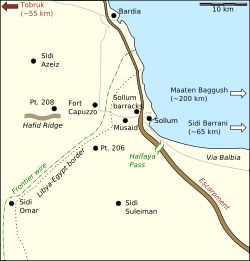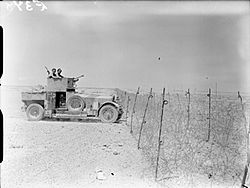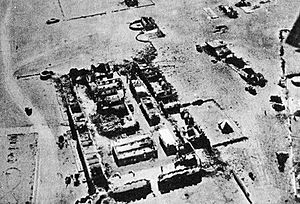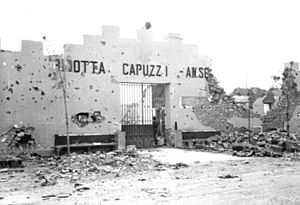Fort Capuzzo facts for kids
Quick facts for kids Fort Capuzzo/Ridotta Capuzzo |
|||||
|---|---|---|---|---|---|
| Part of Western Desert Campaign of the Second World War | |||||
 Map showing Fort Capuzzo |
|||||
|
|||||
Fort Capuzzo (also known as Ridotta Capuzzo in Italian) was a strong fort in Libya. It was located very close to the border between Libya and Egypt. The fort was part of a larger defense system built by Italy.
This system included a long "Frontier Wire" fence. The main road, called the Litoranea Balbo, also passed near the fort. Fort Capuzzo was first built during the Second Italo-Senussi War (1923–1931). This was when Italy was trying to control Libya and stop local resistance.
The Frontier Wire and forts like Capuzzo were meant to stop the Senussi people from moving freely. The fort had strong walls and living areas inside. It served as a base for border guards and Italian army patrols. Fort Capuzzo was a very important location. It changed hands many times during the Western Desert campaign of World War II.
Contents
Why Was Fort Capuzzo Built?
In 1922, Benito Mussolini, the leader of Italy, wanted to fully control Libya. This led to the Second Italo-Senussi War (1921–1931). The Italian army built the Frontier Wire and forts to stop the Senussi resistance. General Rodolfo Graziani led this effort.
The Frontier Wire was a long fence made of barbed wire. It was about 320 kilometers (200 miles) long. It stretched along the border with Egypt and Sudan. Its purpose was to block fighters and supplies from reaching the Senussi.
Along this wire, Italy built three large forts. These were Fort Capuzzo, Fort Maddalena, and Giarabub. They also built six smaller forts. Italian soldiers and border guards patrolled the wire. They used armored cars and planes to watch the area.
Fort Capuzzo in World War II
1940: Early Battles for the Fort
| First Action of Fort Capuzzo | |||||||
|---|---|---|---|---|---|---|---|
| Part of North African Campaign of the Second World War | |||||||
 Rolls-Royce Armoured Car at the Frontier wire, 1940 |
|||||||
|
|||||||
| Belligerents | |||||||
| Commanders and leaders | |||||||
| Francesco Argentino | |||||||
| Units involved | |||||||
| 7th Hussars 1st Royal Tank Regiment 4th Armoured Brigade No. 33 Squadron RAF No. 211 Squadron RAF |
2nd CC.NN. Division "28 Ottobre" Maletti Group |
||||||
| Casualties and losses | |||||||
| 150 | 3,500 casualties 150 killed |
||||||
Just four days after Italy joined World War II, British forces attacked Fort Capuzzo. On June 14, 1940, the 7th Hussars and parts of the 1st Royal Tank Regiment captured the fort. The Royal Air Force (RAF) helped with fighter planes and bombers.
The British did not hold the fort for long. They lacked enough troops and supplies. Instead, they sent teams each night to destroy Italian ammunition and vehicles. The British also began a siege of another fort, Giarabub.
The Italian 10th Army soon moved back into the area. They brought in a strong force called the Maletti Group. This group had tanks, infantry, and artillery. They reoccupied Fort Capuzzo.
On June 29, the Maletti Group fought off British tanks. They also defeated a night attack. From June to September, the British reported causing many Italian casualties. They themselves lost about 150 men.
On December 16, during Operation Compass, the British recaptured Fort Capuzzo. The Italians pulled back from all their frontier forts. The fort then became a supply base for the British 7th Armoured Division.
1941: Fort Capuzzo Changes Hands Again
In April 1941, German forces advanced from El Agheila. They recaptured Fort Capuzzo on April 12. British mobile units tried to bother the German Afrika Korps around the fort. But German attacks forced the British to retreat.
The British launched Operation Brevity in May. Their goal was to take back the area around Fort Capuzzo. On May 15, the 1st Durham Light Infantry and some tanks captured the fort.
However, a German tank counter-attack caused heavy losses. The British were forced to fall back. Italian troops then took over the area between Sollum and Fort Capuzzo.
On June 15, during Operation Battleaxe, the British 7th Royal Tank Regiment attacked Fort Capuzzo. They scattered the Italian defenders. The British tanks broke through the defenses. But their infantry was slow to follow.
The next day, British guards strengthened their position at the fort. German tanks attacked nearby but were pushed back. On June 17, the British faced being surrounded. They were ordered to retreat. The RAF helped cover their withdrawal.
On November 22, the 2nd New Zealand Division captured Fort Capuzzo. This happened during Operation Crusader. The New Zealanders then moved towards Tobruk.
1942: The Final Capture
Axis forces (Germany and Italy) recaptured the fort around June 22, 1942. This was after the Battle of Gazala. They found large amounts of fuel and food supplies there.
After the Second Battle of El Alamein in October-November 1942, Fort Capuzzo changed hands for the last time. German forces retreated from the area on November 9. The British 22nd Armoured Brigade advanced on Fort Capuzzo. By November 11, the last Axis troops had left the frontier area.
After the War
After the Allies won in 1943, Libya was under British control. It became an independent kingdom in 1951. Fort Capuzzo and the Frontier Wire eventually became less important. They faded into history.
See also
- Frontier Wire (Libya)
- Italian Libya




